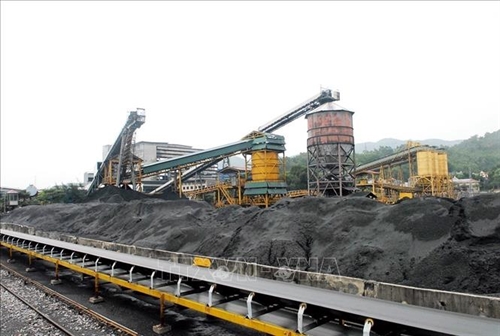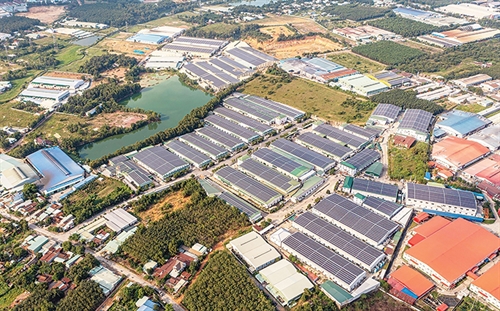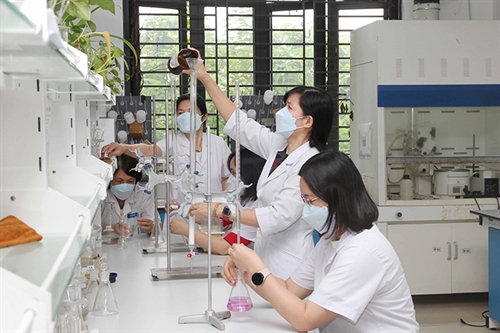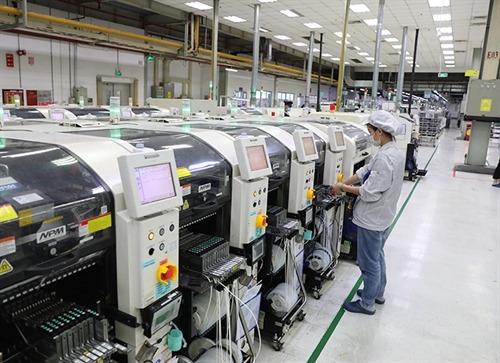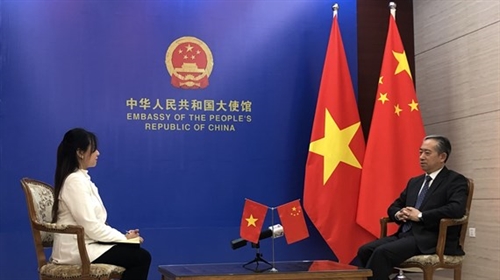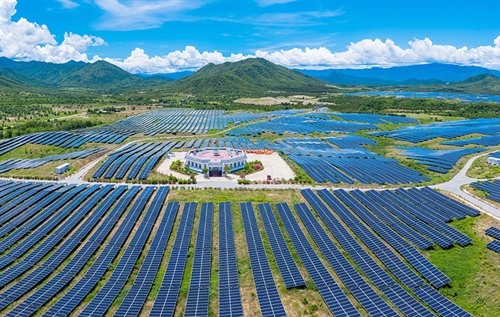 |
| Pham Hong Dao, deputy director of the National Office for Poverty Reduction__Photo: Dantri.com.vn |
Pham Hong Dao, deputy director of the National Office for Poverty Reduction speaks to Dan Tri (Intellectuals) newspaper on the progress of sustainable development in Vietnam and what should be done moving forward.
What are the notable achievements and remaining targets to be achieved after two and half years of implementing the national target program on sustainable poverty reduction for 2021-25?
The strategy for the national target program on sustainable poverty reduction for 2021-25 was approved by the National Assembly (NA) in July 2021, and its program was approved by the Prime Minister in January 2022. The government has directed ministries, departments and localities to develop guidelines, while the NA Standing Committee allocated the central budget for development investment in the 2021-25 period, and 2021, 2022 and 2023 budgets for the program implementation.
Central steering committees for national target programs were also established to manage these projects from the central to local levels, creating a coherent and comprehensive management mechanism. Communications on the program are a focus in implementation and have seen much innovation; while monitoring and evaluation are also strengthened.
Initial results of the program have contributed to the goal of reducing poor households, in accordance with the annual targets set by the NA and the Government. People are aware of actively making efforts to lift themselves out of poverty and working on agricultural production, creating livelihoods and income sources aligning with the local context and the impacts of COVID-19.
In the future, ministries and central, local departments need to continue reviewing, adjusting and perfecting the system of guidelines, promptly allocating funding and mobilizing resources from society, and accelerating the capital disbursement for the program.
They also need to strengthen communications on poverty reduction; raise awareness and improve staff capacity in all levels of the sector; strengthen monitoring and evaluation work to achieve the program’s overall goal of multidimensional, inclusive, sustainable poverty reduction. It is also necessary to have a more synchronized action to minimize people becoming impoverished or falling back into poverty.
They should also work on the support for poor households and people to achieve the minimum living standards, access basic social services according to the national multidimensional poverty line, improve their quality of life, support poor districts and communes in extreme difficulty in the lowlands, coastal areas and islands to escape poverty, in a practical and suitable manner with the local conditions.
The program’s objectives are maintaining the reduction rate of poor households (based on the multidimensional poverty line) at 1 to 1.5 percent per year, and of poor ethnic minority households at over 3 percent per year.
It also aims that 30 percent of poor districts and 30 percent of communes in extreme difficulty in the lowlands, coastal areas and islands to escape poverty. Particularly, the rate of households in poverty in poor districts needs to decrease by 4 to 5 percent each year.
The 2021-22 period saw two different multidimensional poverty lines applied, while these two years were also severely affected by COVID-19. What are the obstacles this has caused to the program implementation?
2021-22 saw two different multidimensional poverty lines applied because the 2016-20 multidimensional poverty lines could not fully reflect the poverty status of households in different regions in 2021. This led to challenges in assessing the poverty reduction goal in 2022 compared to 2021.
In addition, the national target program for poverty reduction was recently approved and is at the initial stage of implementation. Therefore, we are unable to produce a detailed evaluation of projects, sub-projects, and how the shortcomings in basic social services are addressed as part of the program in 2021 and 2022, which included employment, healthcare, education, housing, water and sanitation, and information access.
Poverty reduction results in 2021-22 were also not sustainable as people tended to fall back into poverty due to both subjective and objective reasons, such as COVID-19 impacts, climate change and natural disasters.
Amid these challenges, what has the National Office for Poverty Reduction done in terms of both policy consultation and managing localities to strive for the set goals?
The National Office for Poverty Reduction has actively provided consultation to the ministries and authorities to promptly address the challenges and difficulties that localities face during the program implementation.
The Ministry of Labor, Invalids and Social Affairs (MoLISA) adjusted Circulars No 09 and 17, and addressed 27 recommendations from localities. It also suggested changes to Decree No 27 on the management and implementation of national target programs, as well as the finance minister’s Circular No 46 on managing, using and finalizing non-business funds from the central budget for the 2021-25 national target program on sustainable poverty reduction.
Meanwhile, the National Office for Poverty Reduction consulted the MoLISA in issuing an official document to local People’s Committees’ chairmans on accelerating the program implementation and strengthening its review and assessment across the country.
The Central Steering Committee for National Target Program regularly provides direction and supervision through virtual meetings, directives, notices and dispatches so that localities can promptly issue implementation guidelines.
The office also strengthens the program’s monitoring and evaluation, which focuses on localities with poor districts and communes in extreme difficulty in the lowlands, coastal areas and islands, particularly on mobilizing and using funds to realize the program and its disbursement progress.
Specific aspects such as the use of State budget capital in investment projects, the progress and results of implementing goals, missions and the bottlenecks in the program implementation are all promptly addressed to accelerate disbursement.
In the near future, the National Office for Poverty Reduction will work with the MoLISA on the final review and assessment of the multidimensional poverty line in 2022-25, while also continuing to study and complete the multidimensional poverty line in accordance with the sustainable development goals, ensuring the improvement of minimum living standards and people’s access to basic social services in the period leading to 2030.
For practical results and evaluation, other scopes of implementation include innovating the approach to poverty reduction, and complete the assessment toolkit for multidimensional poor and near-poor households in alignment with the actual situation in localities.
After 2 years of implementation, how has the total fund for the program been used?
Statistics revealed that after 2 years, the total fund for the program implementation from the central budget reached about VND 9.1 trillion (USD 387 million). Of which, VND 543 billion (USD 23 million) was spent in 2021 and VND 8.2 trillion (USD 348 million) in 2022.
This figure only reached 19.1 percent of the estimates for the whole period of 2021-2025 (with about VND 48 trillion (USD 2 billion) from the central budget and VND 12.7 trillion (USD 540 million) from the local budget.
Therefore, to achieve the program's objectives in the remaining period of time, the fund allocation needs to be flexible in accordance with the capacity of the state budget, but still ensure the efficiency of capital structure, avoiding the pressure for disbursement in the program's final year.
I believe that it is necessary to increase resources for the middle years of the program. In addition, ministries, central departments and localities need to maximize socialized resources to implement the program, contributing to the achievement of the set goals.
In your opinion, which direction should be taken so that the program implementation can achieve the set goals?
In order to continue implementing the program comprehensively and effectively in the future, we need to focus on the following measures:
The first is that departments need to continue to review and complete the multidimensional poverty reduction policies and frameworks in accordance with the sustainable development goals, ensuring that the minimum living standard is gradually improved as well as people’s access to basic social services. The approach to poverty reduction should also be innovated, alongside the promulgation of conditional support policies and strengthened social policy credits for the poor.
The second measure is the mobilization and the effective use of investment resources for poverty reduction, and the allocation of funds from the local budget should be conducted reasonably and in accordance with the actual situation in the locality.
There should be an increase in the legitimate contributions from enterprises, local and foreign individuals and organizations, counterpart funds, as well as the engagement of people and beneficiaries, in order to secure the capital needed to accomplish the program's objectives.
The third measure is to strengthen communication, education, raising awareness and responsibilities of all levels, sectors, the entire society and especially the people. This will create a major change in the awareness and actions for sustainable poverty reduction.
We also need to promote the nation’s traditions of solidarity and unity towards the underprivileged, while also encouraging self-reliance and proactiveness in escaping poverty, without much dependence on the help of the state and society.
The fourth measure is the effective management and coordination of the integrated implementation of poverty reduction policies and frameworks, both general and specific, with projects in the 2021-25 National Target Program on Sustainable Poverty Reduction across the country, especially in poor districts and communes in extreme difficulty, coastal areas and islands. This will act as a major driving force for the program.
The fifth measure is capacity enhancement for people working in poverty reduction and those in charge of different aspects of the program to support the poor in escaping poverty, helping people in their self-improvement so that they are not impoverished. To do this, learning and experience exchange sessions in the country and abroad for those directly working on the program’s projects are necessary and must be carried out in sync.
Finally, I believe that the inspection, supervision and evaluation of the program at all levels of authority must be strengthened, in which we should focus on preventive measures against negative behaviors and wastefulness, and addressing violations during the program implementation.- (VLLF)
